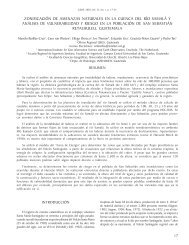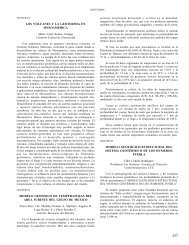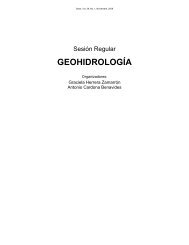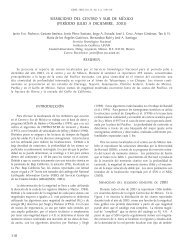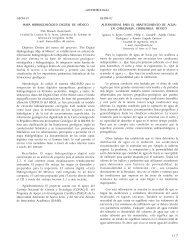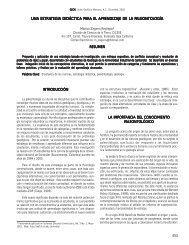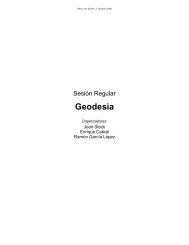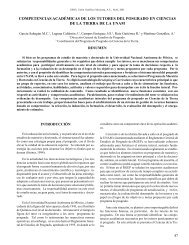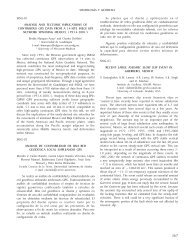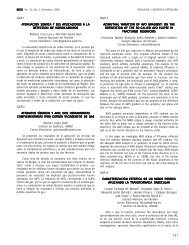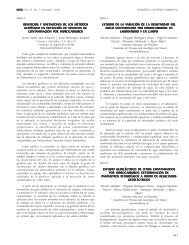Libro de Resúmenes - Unión Geofisica Mexicana AC
Libro de Resúmenes - Unión Geofisica Mexicana AC
Libro de Resúmenes - Unión Geofisica Mexicana AC
You also want an ePaper? Increase the reach of your titles
YUMPU automatically turns print PDFs into web optimized ePapers that Google loves.
Geos, Vol. 30, No. 1, Noviembre, 2010 THE LARGE AND DESTRUCTIVE EARTHQUAKES OF 2010<br />
sísmica liberada para cada uno <strong>de</strong> ellos, y estos valores se compararon con los<br />
reportados por otros autrores. El primero liberó una energía sísmica equivalente<br />
a una magnitud 7.3 < Me < 7.5, en comparación con la magnitud Mw <strong>de</strong><br />
7.0 reportada por las diferentes agencias. A pesar <strong>de</strong> esta diferencia, este<br />
sismo no podría consi<strong>de</strong>rarse anómalo en estos términos, ya que los sismos<br />
<strong>de</strong> corrimiento lateral presentan consistentemente una diferencia positiva. El<br />
segundo liberó una energía sísmica equivalente a una magnitud 8.2 < Me <<br />
8.6, menor a la magnitud Mw <strong>de</strong> 8.8 reportada. Nuevamente, esta diferencia no<br />
parece anómala, en este caso por tratarse <strong>de</strong> un sismo <strong>de</strong> mecanismo inverso.<br />
El tercer sismo liberó una energía sísmica proporcional a una magnitud Me <strong>de</strong><br />
7.4; la diferencia nuevamente es positiva con respecto a la magnitud reportada<br />
Mw <strong>de</strong> 7.2. En este caso la diferencia no es tan gran<strong>de</strong> como para el sismo<br />
<strong>de</strong> Haití a pesar <strong>de</strong> haber tenido un mecanismo <strong>de</strong> corrimiento lateral. A<strong>de</strong>más<br />
<strong>de</strong> estos análisis <strong>de</strong> energía sísmica, presentaremos las inversiones realizadas<br />
para el tensor <strong>de</strong> momentos sísmicos a partir <strong>de</strong> la fase W (fase <strong>de</strong> período largo<br />
entre la P y la S); así como la distribución <strong>de</strong> los valores máximos <strong>de</strong> velocidad y<br />
aceleración presentados por estos tres sismos, tanto a distancias telesísmicas<br />
como aquéllos registrados por el Servicio Sismológico Nacional.<br />
SE13-6<br />
COMPARISON OF MAINSHOCK AND AFTERSHOCK<br />
FOCAL MECHANISMS OF THE HAITI, CHILE<br />
AND MEXICO EARTHQUAKES OF 2010<br />
Hjorleifsdottir Vala 1 , Diehl Tobias 2 y Legrand Denis 3<br />
1 Departamento <strong>de</strong> Sismología, Instituto <strong>de</strong> Geofísica, UNAM<br />
2 LDEO, Columbia University<br />
3 Departamento <strong>de</strong> Vulcanología, Instituto <strong>de</strong> Geofísica, UNAM<br />
vala@geofisica.unam.mx<br />
In a simple “textbook” earthquake sequence, the mainshock ruptures large<br />
patches of a fault plane and the aftershocks occur as a response to stress<br />
concentrations around the edges of the ruptured patches and to stress changes<br />
on other parts of the fault plane. More generally, aftershocks occur as a response<br />
to stress changes in a volume around the ruptured fault patches, on other fault<br />
planes, oriented sub-parallel or at angles to the main fault, as well as on the<br />
same fault(s) as the main shock.<br />
Focal mechanisms provi<strong>de</strong> information on the orientation of the fault planes<br />
ruptured in an earthquake. In this study we compare the mainshock focal<br />
mechanisms of three large earthquakes occurring in the first four months of 2010<br />
to the focal mechanisms of their aftershocks. The mechanisms are obtained<br />
from the Global CMT catalog (globalcmt.org) and from “Nettles and Hjorleifsdottir<br />
(2010)” (for the Haiti earthquake).<br />
The January 14, Mw 7.0 Haiti, predominantly strike-slip earthquake is<br />
remarkable for having only two events larger than Mw 4.5 <strong>de</strong>tected, that have<br />
a similar focal mechanism as the mainshock, and 47 events <strong>de</strong>tected with<br />
predominantly thrust motion (Nettles and Hjorleifsdottir 2010). Assuming that<br />
the mainshock ruptures one planar fault, the overwhelming majority of the<br />
aftershocks cannot occur on the same fault plane as the mainshock.<br />
The February 27, Mw 8.8 Chile earthquake broke a large section of the<br />
subduction interface. The focal mechanism indicates a low angle thrust and<br />
many of the aftershocks have very similar focal mechanisms, pointing to slip on<br />
the megathrust. However, two of the largest aftershocks indicate normal faulting,<br />
one occurring in the outer rise and one in the hanging wall above the thrust<br />
interface.<br />
We present preliminary double-difference locations of part of the aftershock<br />
sequence, supporting the evi<strong>de</strong>nce from focal mechanisms of multiple fault<br />
planes involved.<br />
At the time of writing of this abstract, only the focal mechanisms for two<br />
aftershocks, with magnitu<strong>de</strong>s larger than or equal to Mw 5.5, are available in<br />
the Global CMT catalog for the April 4, Mw 7.2 Mexico earthquake. The focal<br />
mechanisms of both of the aftershocks indicate predominantly strike-slip motion,<br />
similarly to the mainshock, indicating slip on the same fault or sub-parallel fault<br />
strands. The focal mechanisms for events with Mw 5.0-5.5 are expected to be<br />
available for analysis by the time of the meeting.<br />
The three large events presented in this study show a large variety of faults<br />
involved in their aftershock sequences, highlighting the complex interaction<br />
between neighboring faults that can occur after a large earthquake.<br />
SE13-7<br />
COMPAR<strong>AC</strong>IÓN DE LAS DISTRIBUCIONES EN<br />
MAGNITUD, TIEMPO Y ESP<strong>AC</strong>IO DE LAS REPLICAS DE<br />
LOS TERREMOTOS DE HAITÍ, CHILE Y MÉXICO, 2010<br />
Legrand Denis 1 , Rodríguez Miguel 2 , Lermo Samaniego Javier 2 ,<br />
Hjorleifsdottir Vala 1 , Suárez Gerardo 1 y Barrientos Sergio 3<br />
1 Instituto <strong>de</strong> Geofísica, UNAM<br />
2 Instituto <strong>de</strong> Ingeniería, UNAM<br />
3 Servicio Sismológico, Universidad <strong>de</strong> Chile<br />
<strong>de</strong>nis@geofisica.unam.mx<br />
Comparamos las leyes <strong>de</strong> escalamiento en magnitud (Gutenberg-Richter), en<br />
tiempo (Omori) y en el espacio (geometría fractal) para los tres terremotos<br />
<strong>de</strong> 2010 en Haití, Chile y México. El factor b <strong>de</strong> la ley <strong>de</strong> Gutenberg-Richter<br />
es <strong>de</strong> 1.01, 1.18 and 1.09 respectivamente. El valor bastante gran<strong>de</strong> para<br />
Chile muestra un déficit <strong>de</strong> gran<strong>de</strong>s réplicas respecto al número <strong>de</strong> eventos<br />
más pequeños. El factor p <strong>de</strong> la ley <strong>de</strong> Omori es <strong>de</strong> 0.82, 1.07 and 0.81<br />
respectivamente. Este valor bastante gran<strong>de</strong> para Chile muestra que el número<br />
<strong>de</strong> réplicas disminuyo bastante rápido <strong>de</strong>spués <strong>de</strong>l evento principal. Las<br />
dimensiones fractales D son <strong>de</strong> 1.9, 2.45 and 2.49 respectivamente. Los valores<br />
<strong>de</strong> Chile y México muestra una distribución <strong>de</strong> las replicas en un espacio casi<br />
en 3D, que pue<strong>de</strong> ser atribuido al gatillo <strong>de</strong> otras fallas que están localizadas<br />
fuera <strong>de</strong>l plano principal <strong>de</strong> ruptura <strong>de</strong>l evento principal, como por ejemplo las<br />
replicas asociadas a la réplica la más gran<strong>de</strong> <strong>de</strong> magnitud 6.9 que no ocurrió en<br />
el plano <strong>de</strong> ruptura <strong>de</strong>l evento principal, sino en la corteza en el caso <strong>de</strong> Chile.<br />
Se compara también cuales son las replicas las más gran<strong>de</strong>s y cuando ocurren,<br />
alejándose <strong>de</strong> la ley <strong>de</strong> Bath (1965) que estipula que la réplica la más fuerte es <strong>de</strong><br />
1.2 menor que el shock principal. Para los terremotos <strong>de</strong> Chile y México <strong>de</strong>l 2010<br />
es <strong>de</strong> 1.9 y 1.8 respectivamente. Los valores bastante gran<strong>de</strong>s <strong>de</strong>l factor b para<br />
Chile y México son compatibles con este resultado. En el caso <strong>de</strong> Haití y México,<br />
estas replicas ocurren algunos minutos <strong>de</strong>spués <strong>de</strong>l evento principal, mientras<br />
que para Chile la réplica la más gran<strong>de</strong> ocurre 12 días <strong>de</strong>spués. Sabiendo<br />
que estos terremotos tienen mecanismos focales muy diferentes, eso se podría<br />
explicar por el hecho que una gran parte <strong>de</strong>l plano <strong>de</strong> falla rompió durante el<br />
shock principal, in<strong>de</strong>pendiente <strong>de</strong>l tipo <strong>de</strong> mecanismo focal, lo que no favorece<br />
replicas gran<strong>de</strong>s.<br />
189



![Libro de resúmenes [revisión final, 172 páginas] - UGM](https://img.yumpu.com/51565067/1/190x245/libro-de-resamenes-revisian-final-172-paginas-ugm.jpg?quality=85)
